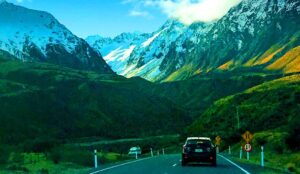Coming around the mountain may sound like fun, but driving on mountain roads with steep slopes can be difficult for drivers and their vehicles. However, with solid driving techniques, you’ll be more ready to navigate mountain ranges securely.
Steep slopes, from the engine to the brakes, may stress your vehicle’s major parts. Fortunately, you can take steps to protect your car, whether you’re driving up or down a mountain route. We’ve compiled ten helpful tips that can lower your risk of a crash in the mountains area. It may help you to stay safe.
1. Ensure that your car is in good condition:
Ensure your gearbox and brake fluids are full and changed according to the time frame suggested for your vehicle. As brake fluid ages, it picks up impurities and moisture that lower its boiling point.
When you use your brakes frequently, the fluid might become overheated, and you could lose braking effectiveness. Additionally, Ensure your tires are filled and inspected for the tread.
2. Fill Up Your Car’s Fuel:
Many individuals are unaware that driving up steep gradients uses more fuel than regular driving. Combining that with the potential lack of gas stations and cell phone coverage in mountainous places, you have the makings of a breakdown.
However, running out of petrol could seriously increase your danger of getting hit by another vehicle on many mountain routes because they frequently have narrow shoulders and poor vision in front of them. So fill up your car before a beautiful mountain drive to avoid this situation.
3. Don’t forget to bring Food, Water, and Extra Gear:
Poor hydration can cause altitude sickness symptoms to appear at higher altitudes. Your alertness may be impacted by them, even if they are minor. It’s necessary to pack enough food, water, and clean clothes to last at least a few days.
Dry clothing could save your life if your clothes get wet for any reason. Also, bring tools like changing a flat tire or belt for simple car maintenance. Wherever you are, roadside help might not be available.
4. Use brakes with caution:
Consider limiting your time spent driving on difficult roads to no more than six hours each day because driving on mountain roads can be more exhausting than on flatlands. Of course, the most crucial advice for mountain driving is to unwind and enjoy yourself. You’ll soon realize why so many tourists, given the option, pick mountainous routes.
Moreover, pay attention to the posted speed limits. When you brake before turns, you transfer the forces to the back of the car rather than the front. It makes it easier to coast through winding roads.
5. Use a Map:
While GPS, telephones, and car navigation systems are functional tools. But the National Park Service warns that they may not function properly in the mountains in many scenarios.
So if you’re driving an RV or pulling a trailer, take the time to map your route on paper. The majority of maps will indicate which roads have severe gradients, allowing you to choose the trip that is the least challenging.
Moreover, using common sense and being aware of your vehicle’s limitations will help keep you safe on our country’s gorgeous mountain highways.
6. Watch Out For Sudden Temperature Changes:
Some mountain passes allow you to go a less distance up and down thousands of feet. The sky will be sunny and clear when you start climbing a mountain.
However, the weather will change from sunny to blizzard. The fog is the main problem when travelling across the Smoky Mountains, especially in the lowlands. In seconds, visibility might change from being completely clear to quite limited. Everything can suddenly start changing on you, including the temperature, the amount of precipitation, and the presence of fog.
7. Watch the temperature of your car’s engine:
Keep an eye on the engine temperature indicator as you ascend and attempt to maintain it within the safe range. It’s necessary to take steps to make sure your engine stays cool:
● Change into lower gear if your car is having trouble as you climb toward the summit to keep your speed steady.
● Pull the windows down and switch off your air conditioning if you travel up a steep incline. Because doing so puts additional stress on your engine and could lead to overheating.
● Allow your automobile to cool off by letting the engine idle for a while once you’ve arrived at that beautiful mountain overlook.
8. Use Lower Gears for Downhills:
When you begin to return downhill, utilize your engine and transmission to slow the car down rather than the brakes. The vehicle can reduce speed with the help of a lower gear without applying the brakes heavily. So shift into it before you begin to descend a slope, says the National Park Service). Use “L” or “2” if your car has an automatic transmission.
However, if you need to brake regularly, stop if you notice a burning smell coming from your brakes. Before you get behind the wheel again, let them cool off, but if you suspect a brake problem, stop immediately. Return to drive and apply the brakes as usual once you are on level ground again.
9. Snow Chains in Winter (Even if it’s Not Snowing):
As you know already, mountains can surprise you with all kinds of extreme weather. Winter is when this is especially true. In many high peaks, snow is measured in feet rather than inches and can only begin to fall after a few hours. Tire chains can save an otherwise disastrous day of driving in the mountains. The local authorities will freeze the entire road to bring you down safely if you become trapped on a mountain road. The cost of it all is something you won’t want to consider.
You probably won’t need tire chains, but you also don’t want to be in a position where you do without them. Therefore, when travelling through the winter highlands, always have tire chains with you. Unfortunately, this is also the law you must follow in many locations, and if they catch you driving without tire chains, they will punish you.
10. Watch out for any animals:
On your travels, you might occasionally come across some wildlife. It is your responsibility to drive slowly enough to react if an animal is on the road because they are not aware of the dangers of the road. In addition, the headlights may cause animals to freeze. Stay Safe and Enjoy the View.
Mountains offer some of the most beautiful driving routes. As you drive through the narrow roads, take some pictures to document the moment. Then, consider having a picnic and taking in the pure country air at a rest stop.
While enjoying the view, you must stay safe. Therefore, health should be your priority. We hope your journey was safe and beautiful.
Stay Safe!









